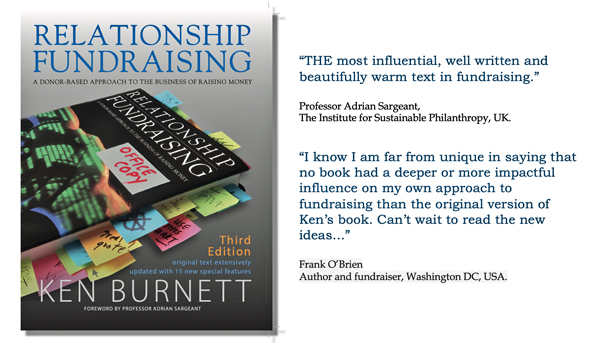|
Blog 20th July 2016. Continuing an occasional series featuring issues Fundraising’s final frontier is the emotional space. It’s found, generally, between the ears of all your important audiences, where the true heart of their emotions sits. Rather than dilute your donors feelings with detail turn them up and turn them to their personal benefit so they can feel deeply about the difference you’ve helped them make. That way you’ll give them a reciprocal gift.
|
Fundraising is full of paradoxes yet none is more ubiquitous, costly, frustrating and perplexing than the seemingly irresistible tendency among fundraisers and their leaders to respond to donors’ emotional needs and reactions with ‘communications’ stuffed to overflowing with what charities want to say rather than what donors would really like to hear. Dull columns of text interspersed with and supposedly supported by charts, diagrams, plans and cases for support, these dense, rational, nigh impenetrable self-justifications usually end up conveying little or nothing. If noticed at all they must seem tedious, wasteful and off-putting to donors. They initially responded emotionally to an emotional appeal and in return just want their emotions reinforced or assuaged, preferably by brilliant feedback that with lump-in-the-throat emotional intensity shows how their gift made a difference, kept a heart beating, lifted lives, raised smiles or otherwise tangibly changed the world just a little bit for the better. This isn’t rocket science, it’s simply what real people want. Something fundraisers might do well to get more familiar with. I put the word ‘communications’ above in quotes because mostly what we call communication is merely information. Information is putting out, while communication is getting through. The difference is fundamental.
Rather than dilute your donors feelings with detail turn them up and turn them to their personal benefit so they can feel deeply about the difference you’ve helped them make. That way you’ll give them a reciprocal gift that will bind them to you and your cause. If donors are angry, stoke their anger by showing how easy it is to do something wonderful. If sad, turn those tears to tears of joy with passionate, moving stories of the change they make happen. If they’re gloomy add a spring to their step by sharing lovely feelings. If fearful, reassure them you’re on hand and action’s being taken. If excited, channel their energy into practical action, or if apprehensive convert their anxiety into reassurance, their unhappiness into joy and satisfaction. Of course you must include the concise, logical case for giving too. A message completely based on emotion may set off alarm bells, particularly in the most logical-thinking types. But without sufficient emotion it won’t reach its intended audience at all. As every emotional storyteller knows, the opposite of passion is indifference. So important is this that fundraising leaders would be advised to lead emotional fundraising personally, from the front – not just to support it but by baring their own souls and emotions to get stuck right into an emotional transformation of their fundraising. An effective fundraising office should be a highly charged emotional space. Too many are not. The passion and warmth should be infectious, palpable, in the air, the rightness and urgency of the mission should shout from every wall and ceiling, from reception through to the meeting rooms and from every surface in between. The charity’s cause should be emblazoned boldly, the voices of your beneficiaries should shout from every corner or Continued top of column 2, above.
|
Continued from column 1, below. corridor not just metaphorically, but actually. It would be extreme to suggest it be filled with donors sobbing into their handkerchiefs with fundraising stress counsellors on permanent standby, but for sure no fundraising space should convey the glum chill of officialdom that typifies the ordinary office, uninspiring because it lacks emotion, it’s merely a place of work. Fundraising’s final frontier is the emotional space. It’s found, generally, between the ears of all your important audiences, where the true heart of their emotions sits, far from the pump they call their heart. If your emotional WHY can occupy this space in your donors, fundraisers and all other staff plus their friends and families too, then you and your fundraising won’t go far wrong. All you have to do then is make being a donor as pleasant and fulfilling as possible. Shouldn’t be too difficult, should it? And as Alan Clayton hints in his quote, above, emotional fundraising is healing and very unifying. Nothing unites fundraisers and donors more than a strong, clear, compelling emotional WHY. © Ken Burnett 2016 Related earlier articles: This article first appeared on Alan Clayton's website. Please note 1. Ken Burnett is managing project 6 for the Commission on the Donor Experience, The use and abuse of emotion. If you have something to add about improving the donor experience emotionally, or if you fancy writing up some emotional case histories, please get in touch. Please note 2: though Ken Burnett was joint initiator of the Commission on the Donor Experience (with Giles Pegram CBE) and is fully committed to helping it to achieve its goals, the views in these blogs are his own. Home page | Current blogs | Article archive
|
|




